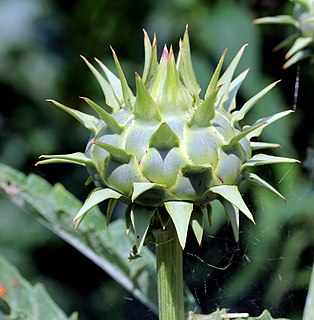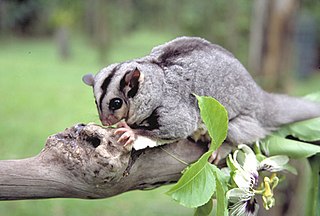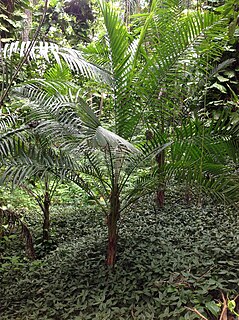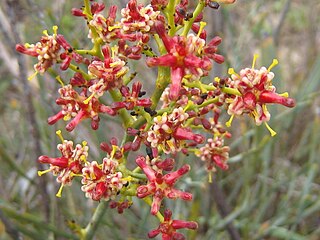
Euglena is a genus of single cell flagellate eukaryotes. It is the best known and most widely studied member of the class Euglenoidea, a diverse group containing some 54 genera and at least 800 species. Species of Euglena are found in fresh water and salt water. They are often abundant in quiet inland waters where they may bloom in numbers sufficient to color the surface of ponds and ditches green (E. viridis) or red (E. sanguinea).

Cynara is a genus of thistle-like perennial plants in the sunflower family. They are native to the Mediterranean region, the Middle East, northwestern Africa, and the Canary Islands. The genus name comes from the Greek kynara, which means "artichoke".

Drosera peltata, commonly called the shield sundew or pale sundew, is a climbing or scrambling perennial tuberous species in the carnivorous plant genus Drosera. Among the tuberous sundews, D. peltata has the largest distribution, which includes eastern and western Australia, New Zealand, India, and most of Southeast Asia including the Philippines. The specific epithet is Latin for "shield shaped", a reference to the shape of the cauline leaves. It is either a single extremely variable species, or a complex of several closely related species of uncertain taxonomic boundaries. In Australia at least four forms have had or still have specific taxonomic recognition: Drosera peltata subsp. peltata, D. peltata subsp. auriculata, D. foliosa and D. gracilis.
Gracilis, a Latin adjective meaning slender, graceful or gracile, may refer to :

Nepenthes gracilis, or the slender pitcher-plant, is a common lowland pitcher plant that is widespread in the Sunda region. It has been recorded from Borneo, Cambodia, Peninsular Malaysia, Singapore, Sulawesi, Sumatra, and Thailand. The species has a wide altitudinal distribution of 0 to 1100 m above sea level, although most populations are found below 100 m and plants are rare above 1000 m. Despite being a widespread plant, natural hybrids between N. gracilis and other species are quite rare.

The mahogany glider is an endangered gliding possum native to a small region of coastal Queensland in Australia.

Reinhardtia is a genus in the palm family native to the northern Neotropics. It is a primarily Central American genus with five species distributed between southern Mexico and the extreme north of Colombia, and one isolated species, Reinhardtia paiewonskiana in the southwest of the Dominican Republic.

Stirlingia latifolia, commonly known as blueboy, is a plant endemic to Western Australia.

Guilleminea is a small genus of plants in the family Amaranthaceae. They are sometimes known as matweeds. These are prostrate, mat-forming perennial herbs growing from taproots. The best known species is perhaps Guilleminea densa, the small matweed, which is present on most continents and is often a weed. The other species are native to the Americas. The genus was named after the French botanist Jean Baptiste Antoine Guillemin.
Maxburretia is a genus of three rare species of palms found in southern Thailand and Peninsular Malaysia. The genus is named in honor of Max Burret, a German botanist.
Wendlandiella is a genus of one species of palms found in Peru, Bolivia and Acre state in Brazil. The genus is named after Hermann Wendland.
Scaphispatha is a genus of flowering plants in the family Araceae. It contains two species, S. gracilis and S. robusta. The genus was believed to be monotypic until 2003 when a new species, S. robusta was discovered by Eduardo Gomes Gonçalves in northern Brazil. The plant had been grown in cultivation for some years, but had always been assumed to be a Caladium until it flowered.
- Scaphispatha gracilisBrongn. ex Schott - Bolivia, Brazil
- Scaphispatha robustaE.G.Gonç. - Pará, Mato Grosso, Tocantins, Goiás
P. gracilis may refer to:
H. gracilis may refer to:
S. gracilis may refer to:
A. gracilis may refer to:
N. gracilis may refer to:

Cautleya is a small genus of perennial plants of the family Zingiberaceae, found in the eastern Himalayas through to China and Vietnam. It consists of two species of high-altitude tropical and temperate plants, native to cool forest areas – an unusual habitat for members of the Zingiberaceae. They are grown as ornamental flowering plants.

Microsteris is a monotypic genus of flowering plants in the phlox family containing the single species Microsteris gracilis, known by the common name slender phlox.
Gracility is slenderness, the condition of being gracile, which means slender. It derives from the Latin adjective gracilis, or gracile (neuter), which in either form means slender, and when transferred for example to discourse takes the sense of "without ornament", "simple" or various similar connotations.









